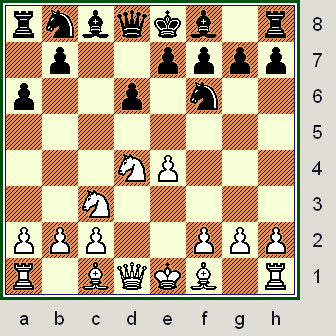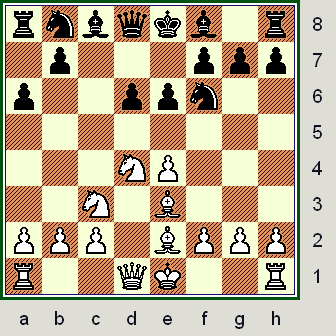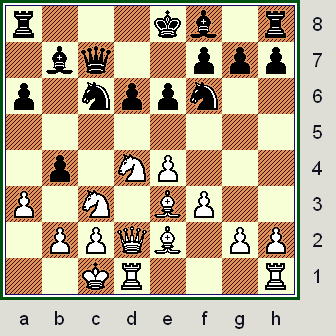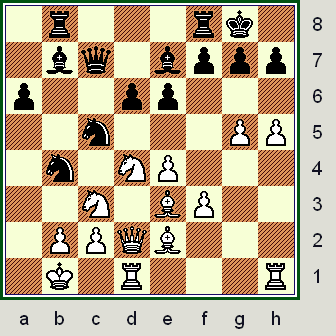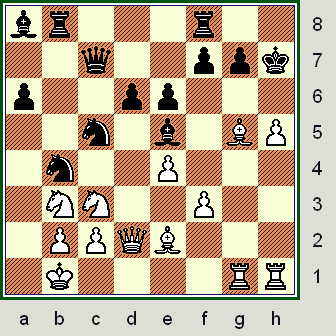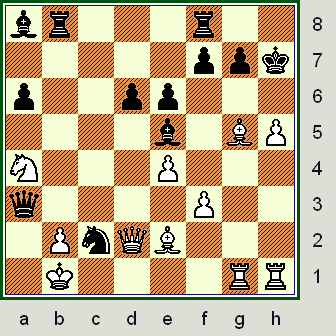GM Michael Adams
(2741) - GM
Garry Kasparov (2804)
|
|
|
One of the more brilliant games that
was played in Linares, and one of the
prettier and most attractive of Garry's
wins as Black;
(for Linares, and
perhaps the whole of his incredible
chess career).
And since Garry is retiring, the allure of examining one last Kasparov game - was simply too great for me to resist.
*** *** *** *** *** *** *** *** *** *** *** *** *** *** *** *** *** *** *** *** *** *** *** ***
{This game contains a - brief? -
look or repertoire of the Najdorf
opening, as well as some limited
investigation into a
few of the
more common transpositions
into the Scheveningen Sicilian.}
(NOTE: I started working on this
game ... within just a few days after
it was played in March. It is now
after April 15th,
and I still do not
feel that it is quite yet ready.)
1.e4 c5;
{Diagram?}
The Sicilian - - a favorite defense of
both Bobby Fischer, Garry Kasparov,
and many other great chess players.
It remains a popular and fighting
defense - a good choice for a player
who is not satisfied with a draw
just because
he has to move second.
White plays an early d2-d4, this line
is known as, "The Open Sicilian."
(The Open Variation of the Sicilian
is generally considered to be White's
most aggressive and promising line,
especially by the majority of numerous,
general reference, opening works.)
2.Nf3 d6;
This is the most normal and common
way - in modern chess - to initiate the
labyrinths of the main lines of the
{Open} Sicilian. (In older chess games,
especially prior to the 1930's, players
would generally play 2...e6;
rather than
2...d6. This approach today is often
seen as less flexible than the more
modern approach, as with
the move
order that is adopted in this game.)
[ Another way of dealing with this
position, and also reaching lines
that are somewhat similar to what
actually occurs in this game, ...
would be the following continuation:
2...e6!?; 3.d4 cxd4;
4.Nxd4 Nf6; 5.Nc3 d6; 6.Be2 a6; 7.0-0 Qc7;
8.f4 Be7;
9.Bf3 Nbd7; 10.Kh1 0-0;
11.Qe1, "+/=" {Diagram?}
and White maintains a solid edge.
(This is verified by both the box
and the games in the database.)
See the super-GM contest:
Garry Kasparov - Nigel Short;
/ (FIDE) World Team Championships
/ (Commonly known as ... "The
Olympiad," a biennial event.)
/
Moscow, RUS; 1994. (1-0, 42 moves.)
[ See - also - MCO-14, page # 292; columns 10-through-12, and all corresponding notes for those lines. ]
*** *** *** *** *** *** *** *** *** *** *** *** *** *** *** *** *** *** *** *** *** *** *** *** ***
( Another idea for White is: 11.g4!? Rd8!?; 12.g5 Ne8;
13.Bg2 Nb6;
14.f5 e5; 15.Nde2!?, "+/=" ('±') {Diagram?}
(and) ... "White is prepared to
launch an attack on Black's King."
Alexander Nikitin - Ivo Nei; / URS Champ. Qualifier, (semi-final)
Riga, LAT; 1952. (1-0, 30 moves)
[ See the excellent book: "(The) Sicilian: ...e6 and ...d6
Systems."
By GM Garry Kasparov and also Aleksander Nikitin.
Chap. # 8, page # 56; Line A.
{Copyrighted by the authors.
Published in 1983 - in G.B. -
for American Chess Promotions.} ) ]
3.d4 cxd4;
4.Nxd4 Nf6; 5.Nc3 a6; {See
the diagram given, just below here.}
The Najdorf Sicilian.
****************************
|
|
****************************
rnbqkb1r/1p2pppp/p2p1n2/8/3NP3/2N5/PPP2PPP/R1BQKB1R (White - move 06)
Bobby Fischer was one of the first
to really popularize this system, but
literally dozens of top GM's have
played it
and made contributions to this particular opening system as well.
In the U.S., one of the most influential
players to {also} adopt this system as
his main opening weapon, was many
-time U.S. Champion, GM Walter S.
Browne. (Kids today do not realize
just how strong he was. Back in the
late
1970's, Browne seemed to win
the majority of the strong swiss
tournaments that he entered. To me,
he seemed
nearly a chess machine,
especially during that time period.)
6.Be3,
(hmmm)
This has become the move of choice
for many top players today ... it is, in
essence, the "The English Attack" vs.
The Najdorf Sicilian. Be3 has also
virtually completely replaced the lines
that were the most popular when I
first
got into chess. (6.Bg5 & 6.Be2.)
[ The main line used to be:
6.Bg5 e6; 7.f4 Be7;
8.Qf3 Qc7; 9.0-0-0,
"+/=" 9...Nbd7;
{Diagram?}
According to the books on modern,
opening theory, White has a fairly
large advantage. (But Black also
scores well from this position.)
See the game:
GM John DM Nunn (2620) -
GM Matthew Sadler (2665);
ICT / Annual Sea-side Resort
/
Premier Section, 9798 /
Hastings, ENG (UK); 1998.
(This was a very long and tough
game, {72 moves}; that was
eventually drawn.)
[ See also: MCO-14, page # 250; columns # 07-12, and all applicable notes as well. ]
**************************************************************************
The other line here for
White, which was commonly played
most often more than twenty
years ago, would
be:
6.Be2 e5!; 7.Nb3 Be7;
8.0-0 0-0; 9.Kh1!? b6!?;
10.Be3 Bb7; 11.f3 b5!;
12.a4!? b4; 13.Nd5 Nxd5;
{Diagram?}
The end of the column.
14.exd5 Nd7; 15.c3!? bxc3;
16.bxc3 Bg5; 17.Bg1 Qc7;
"~" {Diagram?}
GM Nick de Firmian 'scores' this
position as equal. ("=") Several
strong programs
show a distinct
advantage for Black ... I prefer
an evaluation of "unclear."
GM V. Anand - GM B. Gelfand;
ICT / Super Masters (Inv?)
/Dos Hermanas,
ESP; 1997.
{This game was quickly drawn,
perhaps the contestants here
were not inclined
to a real
struggle that day?}
[ See MCO-14, page # 256;
column # 19, and all applicable notes.
Especially see note # (f.) for this
particular column. ] ]
6...e6;
(center)
Kasparov seems to enjoy playing
the Najdorf this way, he was one of
the main pioneers of this method.
(Of playing ...d6; followed by ...e6;
as Black in the Najdorf Variation.
{He even wrote a book about this
whole opening system for Black,
see the note after Black's second
move in this game.})
Technically, this is a transposition into lines that more commonly arise from the Scheveningen Sicilian.
Other lines here for Black would be
6...e5!?; which seems to be the most
common move for Black from
this
particular position. The move 6...Ng4;
enjoyed a brief spate of popularity,
but now seems to have
faded into
the background of top-level chess.
<< B80 Sicilian Defense / Scheveningen
5.Nc3 e6 (transposed). >> - ChessMaster, 10th Edition
(I let the computer "auto-annotate"
this game last night while I slept.
{Wednesday; April 20th, 2005.}
I gave it around 5 minutes per move ...
and just let it run. I wasn't looking
for any deep insights, the
machine
is downright feeble when it comes
to annotating games. I just wanted
some confirmation and
feedback
concerning my analysis. CM 10ed
is one of the most popular of all
the commercial chess programs,
it is also one of the strongest chess
engines on the market. Thus ...
I feel it is silly to totally ignore a
potentially useful resource.)
[ Black often plays an early advance
in the center, especially in the lines
where White plays an early Be2 on
either move six, seven or eight.
For example:
(>/=) 6...e5!?; 7.Nb3 Be7;
8.Be2 0-0; 9.0-0 b6;
10.Kh1 Bb7; 11.f3 b5!;
12.a4 b4; 13.Nd5 Nxd5; 14.exd5 Nd7;
15.c3 bxc3; 16.bxc3 Bg5;
17.Bg1 Qc7;
"~" {Diagram?}
GM Nick de Firmian 'grades' this
position as being rather unclear.
(This is supported by the evaluations
of five different chess programs.)
GM V. Anand - GM B. Gelfand;
/ ICT /
Dos Hermanos, ESP; 1997.
{This game was quickly drawn.}
[ See MCO-14, page # 256;
column # 19, & also note # (f.).
See also page # 262, all lines.
];
**************************************************************
For a long time, the move of
6...Ng4; was thought to be the
virtual refutation
of the English
Attack. Today, that is no longer
true.
One sample line
is:
(</=) 6...Ng4!?;
{Diagram?}
Once an unimportant sideline,
today there are hundreds of
master-level games
that have
arisen from this position.
7.Bg5 h6; 8.Bh4 g5;
9.Bg3 Bg7; 10.Be2 h5; 11.Bxg4!? Bxg4;
12.f3 Bd7; 13.0-0 Nc6;
{Diagram?}
The end of the column here.
14.Bf2 e6; 15.Nce2 Ne5;
16.b3 g4; 17.f4 h4!?; 18.Be3 h3; 19.g3 Nc6;
"="
The position is currently very
balanced - about five computer
programs confirm
(GM
Nick) de Firmian's judgment of "equal" here.
{Black went on to win the game
in thirty-eight moves, however
this was only because White
misplayed his position.}
GM A. Shirov - GM G. Kasparov;
ICT / XIV Super-GM,
(0-1, 38 moves.)
/ Linares, ESP; 1997.
[ See MCO-14, page # 262;
column # 34, and all appropriate
notes,
especially note # (t.). ]
]
7.Be2,
(transposition)
So by the Najdorf route, we are
now fully into a Scheveningen
Sicilian, with all of its complexities.
****************************
|
|
****************************
rnbqkb1r/1p3ppp/p2ppn2/8/3NP3/2N1B3/PPP1BPPP/R2QK2R (Black, move 07)
Some of the main ideas of this
whole system are:
A.) Solid central control, Black has
both e5 and d5 covered by Pawns.
{These two key squares are not
available for White's pieces.}
B.) Rapid development, Black will
almost always castle by move ten.
C.) The second player basically
tries to complete his development
behind his Pawn shield.
D.) Black's structure is solid, sound,
resilient and flexible. The second
player is free to
react to whatever
plan the first party devises.
It is probably because of these
{good} reasons that this system is
so popular, from the club level all
the way to the highest echelons
of master-level practice.
[ White can also play f3 here:
7.f3!? b5!?; 8.g4!? h6;
9.h4 b4; 10.Nce2 e5; 11.Nb3 d5; 12.Ng3 Be6!?;
13.Bd3!? Nbd7; 14.Qe2!? a5;
15.Rg1 a4,
"=/+" {Diagram?}
Black is clearly better, and maybe
very much so here. ("/+")
See the crucial contest:
Vishy Anand - Boris Gelfand;
ICT / Super-GM /
Round #03
Linares, ESP; 1994.
(1/2, 44 moves.)
[ See the excellent book:
"The
Complete Najdorf: Modern Lines," (©
1998)
by GM John Nunn, and
also GM Joe Gallagher.
Chapter 09, page # 188; Line # A,
and all appropriate notes. ] ]
7...Qc7!?;
(double-hmmm)
Kasparov decides to develop his
Queen early ... rather than commit
any of his pieces to a set configuration.
Needless to say, this is a little unusual,
and even a touch risky. (The computer
verifies that White retains an edge,
almost no matter what Black plays.)
Black could also play his Bishop to e7, or his QN to the d7-square as well.
A detailed search of the database shows
that this continuation, (7...Qc7);
is very
popular as of late, many highly
rated
players have given it a try.
[ Black could also play:
7...Nbd7; 8.g4 h6!?;
{Diagram?}
Pushing the Pawn to the d5-square
looks like a reasonable alternative.
9.f4 Nc5; 10.Bf3 e5;
11.Nf5 Bxf5!?; 12.exf5! Qb6;
13.Nd5!? Nxd5; 14.Qxd5,
"~" ("+/=") {Diagram?}
MCO-14 renders an evaluation
of "a plus over a line" here. ('±')
I am not sure if this is valid.
(After 13...Qxb2;
15.0-0, Rc8;
White has good play for the Pawn,
but how much more so remains
to be seen.)
Liang Jinrong - Ruben Rodriguez;
/
ICT / Asian Championships
Penang, Malaysia; 1991. /
{White won a lopsided game, 1-0,
in only 33 total moves.}
[ See MCO-14, page # 292; column # 12, & also note # (v.). ];
***************************************************************
Another common continuation is:
7...Be7;
8.f4 Nc6; 9.0-0 Qc7; 10.Qe1 0-0; 11.Qg3,
"+/=" {Diag?}
which is a very common position
for the Scheveningen Variation.
See the contest:
GM A. Shirov - GM J. Benjamin;
/ ICT / Horgen CS /
1994. (1-0)
{White won an exciting and a very
interesting game in 33 moves.}
[ See also MCO-14, page # 289;
mainly column # 04, and all
applicable notes for this column. ]
]
8.Qd2,
(dark-squares)
This is part {and parcel} of this whole
opening line. Generally this system
is outlined by the moves Be3,
Qd2,
0-0-0, f3, and g2-g4. And it seems
that these moves can be played ...
almost no matter what variation
or move order that Black adopts.
[ The (old) main line from this
position used to be:
8.a4 Nc6; 9.0-0 Be7;
10.f4, "+/=" 10...0-0;
{Diagram?}
White has a small, but solid edge,
while Black definitely has
a fair
amount of play from this position.
See the following crucial game:
GM Vishy Anand - GM Garry
Kasparov;
ICT / XIV Ciudad de Linares
/
(Super-GM) / Linares,
ESP; 1997.
{Black won this contest; 0-1 in 41.}
This is technically a hybrid position,
it could have arisen out of a normal
Scheveningen Sicilian, as well as
The Najdorf. [See MCO-14.]
***************************************************************
Another line for White here is
to play 8.g4, which has lead to
some pretty
flashy wins for White.
However, not all is smooth sailing
for the first player.
For example:
8.g4!? d5!?; ('!')
9.exd5 Bb4!; 10.dxe6!? Bxc3+; 11.bxc3 Qxc3+;
12.Kf1 fxe6!;
"~" {Comp?}
{Diagram?}
Black had good play, and went
on to win an extremely impressive
game
in just thirty-three moves.
GM Alexei Shirov
(2740) -
GM Vassily Ivanchuk (2695);
Masters / Sicilian Theme Tournament
/
Buenos Aires (14), ARG; 10,1994.
]
8...b5!;
Black advances on the Queen-side.
While some might see this Pawn
thrust as dangerous or premature,
Black must take some risk ...
and
"push the envelope," {so to speak}
if he is to
obtain a satisfactory game in the
Najdorf Sicilian,
(or the various
branches of the Sicilian that are
reached by transposition). And as
White has already
moved his KB,
there is less chance that he will
sack on b5.
***
Please note WHY this move is so
good for Black ... and why it creates
so many opportunities for
the second
player in the Sicilian.
# 1.) It gains space on the Q-side,
Black can now fianchetto his QB.
Also - there is a Knight outpost
on
the c4-square that Black might take
advantage of later in the game.
# 2.) It undermines White's chances
and play on the Q-side. The most
important of these ideas is to
play
...b5-b4; and kick the White QN
off its very best square.
# 3.) Because of the above two
reasons, Black is {possibly} in a
better position to play the freeing
advance (...d6-d5) in the center.
[ Or 8...Be7; 9.0-0, "+/=" {Diag?} and White is slightly better. ]
9.a3,
(prophylaxis)
White must prevent Black from
playing the Pawn advance of
...b5-b4; or risk losing most of
his edge out of the opening phase.
[ After the moves:
(</=)
9.f3!?, ('?!') 9...b4;
10.Na4 d5!; "~" {Diagram?}
Black has nearly equalized.
****************************************************************
The continuation of:
</= 9.Bxb5+?! axb5;
10.Ndxb5 Qc6; 11.a4 Be7;
"/+" {Diagram?}
simply does not give White
enough play for the material. ]
9...Bb7;
10.f3 Nc6!;
Black develops his Knight to its
most natural square, most of the
time this piece comes into the
game via the d7-point.
{Especially in the Najdorf Sicilian.}
Both the CB "Power-Book" ... and also CM 10th Edition confirm that this is a departure from the more 'normal' <book> lines.
[ Black can also play:
(</=) 10...Nbd7; 11.0-0-0 d5!?;
{Diagram?}
The computer adores this move ...
but it could be premature.
12.exd5 Nxd5;
{Diagram?}
Black's position looks reasonable,
yet ALL the master-level games
in the
database with this position
end in a win for the player of the
White pieces!
13.Nxd5 Bxd5; 14.Kb1,
"+/=" {Diagram?}
White is slightly better, the Q-side
majority is most significant in the
coming endgame.
See the contest:
GM Michael Adams - GM Veselin
Topalov;
FIDE World Champ, K.O. (R #5)
/
New Delhi / Teheran, 2000.
{White won a well-played game.
It ended after move 70, in a hard
victory for White ... after a very
strenuous R+P ending.} ]
11.0-0-0N,
('!?')
Adams has obvious aggressive
intentions here, but his position
soon blows up in his face.
Maybe the exchange on c6 - as
was played in one correspondence
game - in a very similar
position -
was just a little better here.
A search of the on-line database
reveals that this might be the first
time that anyone tried 0-0-0
in
this particular position. {A Theoretical Novelty ... or "TN."}
[ (>/=) 11.Nxc6 Bxc6; 12.Bd4, "+/=" ]
11...b4!;
(play!)
Garry immediately breaks on the
Q-side without delay.
****************************
|
|
****************************
r3kb1r/1bq2ppp/p1nppn2/8/1p1NP3/P1N1BP2/1PPQB1PP/2KR3R (White, move 12)
One might think this is premature,
'theory' generally holds that Black must complete his King-side
development before
attempting any
such maneuver. However, I have
noticed during training games with
the computer that it will also play
this way. (Was this the inspiration
for Garry's idea here?)
Another good reason for Black to
'hurry up' with his Q-side play, is
that slower methods from these
types of positions
do not seem to
give Black an adequate amount of
counterplay in these systems.
[ After the moves:
(</=) 11...Be7!?; 12.g4 0-0;
13.Nxc6, {Diagram?}
The most direct method.
** ** ** ** ** ** ** ** ** ** ** ** ** ** ** ** ** ** ** ** ** ** ** **
( A different way to play this
position would be:
13.g5 Nd7; 14.h4 Nce5;
15.f4 Nc4;
16.Bxc4 Qxc4; 17.f5 Rfc8;
18.g6, "+/=" {Diagram?}
White is left with the initiative ...
and a slight pull in this position,
(according to Fritz 8.0).
GM Peter Leko
(2713) -
GM Loek Van Wely (2697);
ICT / CORUS Master's "A"
/ Wijk aan Zee (1), NED; 01,2002.
{White won a convincing game in
forty-one total moves.} )
** ** ** ** ** ** ** ** ** ** ** ** ** ** ** ** ** ** ** ** ** ** ** **
13...Bxc6; 14.g5 Nd7;
15.h4, "/\" (Maybe "+/=")
{Diagram?}
White is left with a distinct pull
in this position. (I found NO
significant,
master-level games
to match this position ... in any
of the various db's
that I searched.) ]
White's next move is virtually forced.
12.axb4 Nxb4;
13.g4 Be7;
Black continues to develop.
[ The other option was:
13...Nd7!?;
"~" {Diagram?}
which also yields a fair position
for Black. (Maybe "=/+") ]
14.g5 Nd7!;
15.h4 Nc5; 16.Kb1, ('!?')
Getting the King off the c-file ...
but somehow the b-file does
not look that inviting either!
[ Or if
16.h5!?,
then 16...d5!;
"~" {Diag?}
looks good for Black. (Maybe "=")
]
16...Rb8!,
(Hello!)
Being the kind, friendly, neighborly
sort of fellow that Garry is; his Rook
immediately sends out a
'greeting
card' ... to welcome the White King
into his new digs.
[ </= 16...Qa5!?; 17.Bc4! Rc8?; 18.Nb3 Nxb3; 19.Bxb3, "+/=" ]
17.h5 0-0!;
(Maybe - '!!') {See
the diagram given here - just below.}
Seemingly ... Black is castling into
it here. However, as the variation,
{given just below}; adequately
proves,
Black could still lose this
contest with less than perfect play.
****************************
|
|
****************************
1r3rk1/1bq1bppp/p2pp3/2n3PP/1n1NP3/2N1BP2/1PPQB3/1K1R3R (White, move 18)
Indeed, Fritz 8.0, after several minutes of analysis awards White an edge of more than 1/2 a pawn!
However, there is a storm coming,
and in the ensuing maelstrom of
complications, Garry has foreseen
the need for his KR to be able to
enter the fray without hesitation.
[ Black can lose from this position,
as the following piece of analysis clearly demonstrates.
</=
17...d5!?; 18.g6! dxe4!?;
19.h6!! fxg6!?; 20.hxg7 Rg8; 21.Rxh7 exf3?!;
22.Bf4!! e5; 23.Rh8 fxe2;
24.Qxe2 Nbd3; {Diagram?}
This is probably forced.
( Not </= 24...Kf7?; 25.Bxe5!, ("+/-")
{Diagram?}
and Black's exposed King is
doomed from here. )
25.Rxd3! Nxd3; 26.cxd3 Kf7;
27.Bxe5 Qd8; {Diagram?}
This is also {probably} forced.
( Not </= 27...Bd6??; 28.Qf2+ Ke7; 29.Qf6+ Kd7;
30.Qe6+ Kd8; 31.Rxg8+, ("+/-")
{Diagram?}
and mate next move. )
28.Qg4! Bc8; 29.Qf3+! Bf6;
30.Nc6!, ("+/-")
{Diagram?}
and Black's game is hopeless,
as the second player must give
up the Queen to avoid mate. ]
Now it's a question of which player
will be able to get his attack going
the quickest from the current position.
(This is a common theme when both
players have castled on opposite
sides of the chess-board.)
18.g6! Bf6!;
19.Rdg1!?,
"Student body ....... RIGHT!!"
I watched this game as it was
being played on the Internet.
At this point, I was unsure of who
was better in this position.
[ After the moves:
("=") 19.gxh7+ Kh8!;
20.h6!? g6!; "~" {Diagram?}
Black has open lines, while White's
avenues of attack on the Kingside
are nearly all shut. ]
Black's next move is good simply
because the Black Bishop ... which
currently is not all that vital ...
steps out of the way for the Black
Rook on the b8-square, who has
dirty business to attend to on
the
b-file here.
19...Ba8!;
20.Bg5,
One cannot say that Adams is not
at least making a brave effort to
get his assault started on the Kingside.
(If White can trade off Black's KB,
he might be able to make meaningful
progress in his King-side ventures.)
Shredder 9.0 likes 20.Rg4 in this
position. I spent several hours (one
sunny spring morning) looking at the
variations that arise from this move,
but never came to any real conclusion
about its value. (It might be better
than 20.Bg5, but I cannot say for
certain ... ... ... not with any degree of authority.)
[ Apparently the players looked at 20.Bh6!? after the game, see the book by GM Neil McDonald for more
details and the analysis of this move. ]
[ Or if:
20.gxh7+!?,
then 20...Kh8!,
"=/+" {Diag?}
{See the note after White's 19th
move in this game.} ]
20...Be5!;
(avoidance)
Garry's excellent footwork keeps
him just beyond arm's length, out
of reach of Michael Adams'
very
dangerous jabs.
[ After the moves:
(</=) 20...fxg6!?; ('?!')
21.Bxf6! Rxf6; 22.hxg6 h6;
23.Ncb5!,
23...axb5; 24.Qxb4,
"~" (Maybe "+/=")
{Diagram?}
White might be OK here. ]
21.gxh7+ Kxh7!;
22.Nb3?, ('??') {See
the diagram given - just below here.}
Adams - understandably - makes
an error (blunder?) under all the
tension that he has been subjected to.
(Adams used quite a bit of time for
his first twenty or so moves.)
****************************
|
|
****************************
br3r2/2q2ppk/p2pp3/2n1b1BP/1n2P3/1NN2P2/1PPQB3/1K4RR (Black, move 22)
As things are about to get really hairy, a close look at the position is definitely in order.
[ After
'=' 22.h6?! g6!, "=/+"
{Diagram?}
the initiative ("/\")
is firmly in Black's
capable hands.
******************************************************************
After the much superior move of:
>/= 22.Be3,
"~" (!) (Maybe "=/+")
{Diagram?}
it is by no means clear what the
outcome of this game would be.
Several - VERY strong! -
commercial chess programs, (to
include Fritz 8.0
and also ChessMaster 10th Edition); confirm that
the correct move for White
here
is Be3. (Although Black might still
have a tiny edge.)
(I have deeply analyzed these lines ...
I feel that they are more appropriate
for a possible book, than this column.)
]
Now Garry is ready to shoot off
some fireworks. (Garry's next move
may be worthy of two full exclams,
the complications and the various
branches of this combination are
not easy to work through.)
22...Nxc2!; ('!!')
23.Nxc5[],
According to Dr. Fritz, this move was
pretty much forced for White.
[ </= 23.Qxc2? Nxb3; ("-/+") ]
23...Na3+!;
A nice "in-between-move,"
although taking the White Knight
on c5 was also still good enough
for at least a small advantage.
24.Ka2[],
Without question, this was completely
forced for White here.
[
</= 24.Kc1?! Qxc5;
25.bxa3? Bxc3; ("-/+")
{Diagram?}
(This is just one example of how
White can lose - after 24.Kc1?!) ]
24...Qxc5;
25.Na4!?, ('?')
Basically, this is a (slight?) mistake. But as it comes in a position that is
already completely {dead} lost,
it is
difficult {for me} to be too harsh on
GM Michael Adams here.
Perhaps Adams saw that Rc1 was
easily met by ...Nc4; so he might
have decided to play something else ...
in the hopes to throw his opponent
a small curve ball.
[ After the straight-forward moves:
>/= 25.Rc1 Nc4;
26.Bxc4 Qxc4+; 27.Ka1 Qb4; ("-/+")
{Diag?}
Black has a winning attack.
*********************************************************
Of course not:
</= 25.bxa3?? Bxc3;
{Diag?}
and Black is winning ("-/+") here. ]
25...Nc2!!;
IMPRESSIVE!!!!!!!
Garry waves his hat at Adams'
threat to capture his Queen.
(Now 26.Nxc5, is easily met by the
sublime move of 26...RxP/b2#!)
It is the fact that Garry finishes this
contest with so much flair ...
that
makes this particular game so
very special, at least to me.
White's next move appears to be
forced, many of the alternatives
were unthinkably bad.
26.Kb1[],
26...Qa3!; ("-/+") White
Resigns. (0-1)
****************************
|
|
(The final position after 26...Qa3.)
****************************
br3r2/5ppk/p2pp3/4b1BP/N3P3/q4P2/1PnQB3/1K4RR (After B's 26th move.)
The final position of this magnificent GM battle royale ... is worth both a look and a diagram.
Great play by Garry ... many feel he
is the best player ever! Certainly the
way that he man-handles a near
2750-rated player ... WITH THE
BLACK PIECES ... is a testament to
his (unbelievable?) chess strength!!!
********************************************
Bibliography
When I analyzed this game, there was very little help ... it was "hot off the presses," so to speak.
However, today this game has been analyzed in at least two books that I know of:
-
NOTE: GM Igor Stohl does a very fine and extensive analysis of this grand contest in his book:
<< "Garry Kasparov's Greatest Chess Games," (Volume 2). >> [Game # 129, page # 340.]
This excellent book is well worth having, every game of Garry's is DEEPLY annotated!
Copyright (c) to the author, published by Gambit Publications, Ltd. in 2006.
ISBN: # 1-904600-43-3.
-
This game is (now) annotated in the book, (Game # 10, pg. # 66):
<< The Art of Planning in Chess >> Move by Move, by GM Neil McDonald.
Published in 2006 by Batsford books. ISBN: # 07134 - 9025X
Copyright (c) A.J. Goldsby, 2005. All rights reserved.
